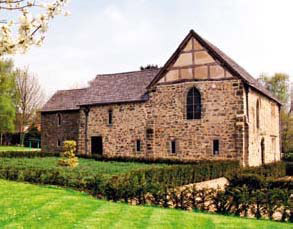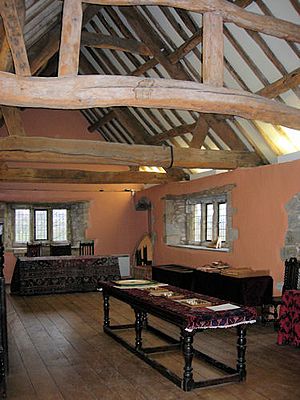Donington le Heath Manor House Museum facts for kids
Donington le Heath Manor House Museum is now called 'The 1620s House and Garden at Donington le Heath'. It is a very old manor house built over 700 years ago. You can find it in Donington le Heath, close to Coalville in Leicestershire.
This historic house was once owned by a family member of one of the famous Gunpowder plotters. Today, Leicestershire County Council takes care of it. The museum is officially recognized by the Museums, Libraries and Archives Council (MLA).
Contents
History of the Manor House
How Old is the House?
The museum is located in a medieval manor house. Experts believe it was built around the year 1290. We know this from the way parts of the building were designed. Also, by checking the age of the wood used, we can tell it was likely built between 1288 and 1295.
Who Lived Here?
A house on this land, and the current building, belonged to Charley Priory. Later, it was owned by Ulverscroft Priory until the 1530s. Many people rented and lived in the house during this time. Robert and Isabella de Herle were likely the ones who built the house we see today.
Changes Over Time
Around 1618, the Manor House got a big makeover. This was discovered by looking at its features and dating the wood in the roof. The storage rooms downstairs were changed into a kitchen and a living room, called a parlour. A new roof was added, and the upstairs rooms were updated. They even put in a new staircase inside. From the outside, you can see large, rectangular windows that were added then.
At this time, the house was probably owned by John Digby of Seaton. His nephew, Sir Everard Digby, was a friend of Robert Catesby. Robert Catesby was the leader of the Gunpowder Plotters.
From Farm to Museum
From 1670 to 1960, the house was rented out as a farm. The money earned helped support a hospital and an orphanage. In 1965, Leicestershire County Council bought the Manor House. It had become a pig farm and was in bad shape. A big project began to save the building. The Manor House opened as a museum in 1973.
The Digby Family and the Gunpowder Plot
The Digbys as Owners
Members of the Digby family rented Donington le Heath Manor House from the early 1400s. They then owned the house and its land from the 1530s until 1627. The main home of the Digby family was in Tilton on the Hill. However, they owned land in many other areas too.
Sir John Digby fought for Henry Tudor at the Battle of Bosworth in 1485. When Henry won and became King Henry VII, he rewarded his supporters. It is thought he gave back lands the Digbys had lost earlier.
A Family's Beliefs
In the early 1600s, John Digby of Seaton owned the property. John was a known Catholic. At that time, being Catholic in England could be difficult. John and his family were often fined and kept out of the Church of England. John himself was once held in the Tower of London. This was because he was suspected of being involved in a plot against Queen Elizabeth I.
His nephew, Sir Everard Digby, had moved away. He married a rich woman and became friends with Robert Catesby. Catesby was the leader of the Gunpowder Plotters. Sir Everard was asked to start a rebellion in the Midlands. This was planned to happen after the plotters blew up Parliament. He also planned to kidnap Princess Elizabeth, King James I's daughter. Sir Everard was executed in 1606 for his part in the plot. John Digby passed away in 1627. After that, the Donington property was divided between two families.
The House Today: A Glimpse into the Past
In 2016, the house was updated and reopened as 'The 1620s House and Garden'. It now tells the story of the Catholic Digby family living in Protestant England. All the rooms are set up as they would have looked back then. You can touch and use most of the furniture and objects. Some are original, and some are copies.
There is one special item: a beautifully carved four-poster bed. Some people thought it was connected to the Blue Boar Inn in Leicester. King Richard III is believed to have stayed there before the Battle of Bosworth. So, it became known as King Dick's Bed. However, its style shows it was made much later than 1485. It fits perfectly into a home from the 1600s.
Friends of the Museum
The 'Friends of Donington le Heath Manor House' is a group that helps the museum. They raise money to support its growth and development. They also fund much of the work done in the gardens. This group is a Registered charity (Number 1084997).





